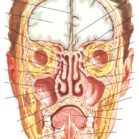Mouthwash
Updated October 23, 2024
Mouthwash ingredients: oils of cinnamon, clove, eucalyptus, frankincense, peppermint, rosemary, spearmint, tea tree, thyme and wintergreen in a base of iodine, niacinamide, 0.375% hydrogen peroxide, boric acid, borax, and xylitol. Minimal grain alcohol added as a dispersant.
Update 4/2024: Version D42 has added coconut oil as an anti-viral and other features; xylito increased to make a tad sweeter
Update 1/2024: Version C38 is now made with CKIS, yielding a higher total iodine level while lowering the potentially irritating effect of molecular iodine (I2) that is in Lugols.
Update 8/2023: Also added oils of Black Seed and Neem.
Update 11/2023: Increased xylitol from 3.3% to 4 or 5%; increased Iodide from 25 ppm to 619 ppm (CKIS) and decreased I2 from 25 ppm to 13 ppm
Most commercial mouthwashes contain chlorhexidine and/or fluoride. Most research compares agents to chlorhexidine (at 0.02% (2000 ppm)) which is effective but also toxic, staining and can affect mouth/gut ecology. Flouride 0.01% (100 ppm) is also in most oral products. Both of these concentrations are utilized world-wide.
The hydrogen peroxide (H2O2) is 6-8 times less than the 3% hydrogen peroxide in the stores (sometimes recommended by dentists). Teeth whitening strips can be as high as 6% H2O2 and dental offices can use up to 12% for teeth whitening. However, my research and personal use has suggested that even at 0.5% (5,000 ppm) or lower H2O2 is very powerful. We use food-grade hydrogen peroxide, while the stuff sold in stores is primarily for external use such as bleaching hair (however it can be used occasionally in the mouth if necessary).
The iodine content is approximately 25 ppm, a concentration used in the beer and other industries to disinfect surfaces. The essential oils, especially clove, have been used in the mouth for centuries and contain components that are both anti-microbial and anti-pain. The wintergreen and peppermint oils have anti-inflammatory functions. The xylitol component is non-caloric sugar that when ingested by certain yeasts and bacteria kill them. The niacinamide is in virtually all skin products to help with repair, and it is proven to do the same with gums and probably the other connective tissues in the mouth. It helps prevent skin cancer (New England Journal of Medicine, 2015) and probably other cancers as well. The boron (borax and boric acid) helps with bone healing and is also anti-microbial (especially yeasts such as Candida). The slightly alkaline pH counteracts the bacterial acids that decay teeth.
It is best used in conjunction with oil pulling, tongue scraping and brushing with baking soda. Since the upper teeth often enter the maxillary sinuses, using a sniffer can be an essential part of healing the skull.
MOUTHWASH INSTRUCTIONS
Shake well before use. Separation means less chemicals! Real essential oils may affect plastics, eyeglasses, skin and other surfaces — test on small area before using.
- Start with 2 tsp of mouthwash, 1x/day, 6 days/wk;
- Swish for 1-5 minutes, including gargling;
- Can be done while in shower and spit down drain;
- Can increase to twice a day (am, bedtime) if needed;
- Can be diluted or further enhanced under practitioner supervision with additional agents.
Mouthwash Concentrate Directions
Do NOT mix concentrated directly with H2O2–dilute concentrate before mixing in the H2O2!
Steps:
- Start with 1 oz concentrate
- ADD 6 oz distilled or filtered water
- THEN AD 1 oz H2O2 3%, food-grade or regular
- Keep top of container loose for approximately 60 minutes to allow for release of oxygen
- Mouthwash will turn red/pink, the appearance and disappearance of the color will last anywhere from hours to days, but does not have a major impact on the function of the mouthwash.


